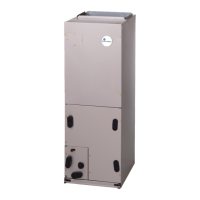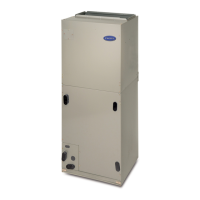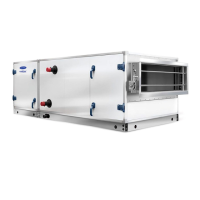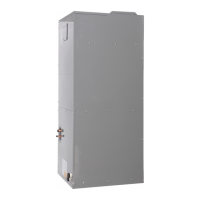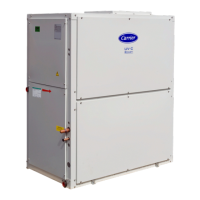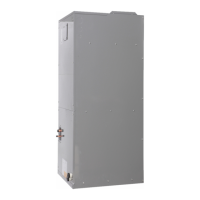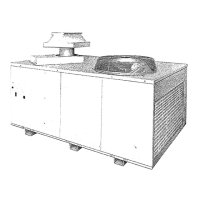86
building pressure drops below the BP.SP minus the building pres-
sure set point offset (BP.SO) for 5 continuous minutes, building
pressure control will be stopped. The 5 minute timer will continue
to reset while the VFD is commanded to a position > 0%. If the
building pressure falls below the set point, the VFD will shut
down automatically. Any time building pressure control becomes
active, the exhaust fan relay turns on which energizes the exhaust
fan VFD.
After the exhaust fan relay turns on, PID control ensues without an
“I” term:
Error = BP – BP.SP
K = 1000 * BP.TM / 60 (normalize the PID control for run
rate)
P = K * BP.P * (error)
D = K * BP.D * (error – error computed last time through the
PID)
VFD control signal (clamped between 0 and 100%) = VFD
Output last time through + (P + D)
NOTE: The sum of P + D will be clamped on any timed calcula-
tion to an internally calculated value which guarantees the VFD is
not commanded more or less an amount than it can achieve before
the next time VFD capacity is again calculated. Bringing the sin-
gle speed fan (P.E.2) ON and OFF is coordinated with the VFD
speed. When building pressure first becomes active, P.E.2 is OFF,
P.E.1 is ON and the VFD is allowed to climb to 100%. BP.CL will
be used to act as hysteresis so that when the P + D term is evaluat-
ed and it exceeds BP.CL, the control will go through a one-minute
period hold off time where the VFD is commanded to BP.CL, and
P.E.2 is brought on. After the transition to P.E.2 ON is complete,
the control will continue to control the VFD from BP.CL%. If BP
rises, the control will speed up the VFD. Should the VFD drop to
0%, and the next time through the PID the P + D term calculation
is less than – BP.CL, the control will go through another one-min-
ute PID hold off period where P.E.2 is commanded OFF and the
VFD is commanded to 100 – BP.CL.
Configuration
BP
BP.CF =5 (Fan Tracking)
The fan tracking algorithm controls the exhaust/return fan VFD
and the exhaust fan relay. The ComfortLink controls use a flow
station to measure the flow of both the supply and the return
fans. The speed of the return fan is controlled by maintaining a
delta cfm (usually with supply airflow being greater of the two)
between the two fans. The building pressure is controlled by
maintaining this delta cfm between the two fans. In general, the
greater the delta between supply airflow and return airflow, the
higher the building pressure will be. Conversely, as the return
airflow quantity increases above the supply airflow, the lower
the building pressure will be. Whenever there is a request for the
supply fan (or there is the presence of the IGC feedback on gas
heat units), the return fan is started. The delta cfm is defined as
S.CFM – R.CFM. The return fan VFD is controlled by a PID on
the error of delta cfm actual from delta cfm set point. If the error
is positive, the drive will increase speed. If the error is negative,
the drive will decrease speed.
NOTE: These configurations are used only if Fan Tracking Learn-
ing is enabled. When Fan Tracking Learning is enabled, the con-
trol will adjust the delta cfm (FT.ST) between the supply and re-
turn fan if the building pressure deviates from the Building Pres-
sure Set Point (BP.SP). Periodically, at the rate set by the fan track
learn rate (FT.TM), the delta cfm is adjusted upward or downward
with a maximum adjustment at a given instance to be no greater
than fan track max correction (FT.AD). The delta cfm cannot ever
be adjusted greater than the Fan Track Max Clamp (FT.MX) or
less than the Fan Track Minimum Clamp (FT.MN).
Configuration
BP
BP.CF = 6 (Return Fan/Power Exhaust
Control)
The control subsystem shall set Return Fan VFD Speed Percent
such that the difference between Building Pressure (Pres-
sures
AIR.P
BP) and Building Pressure Setpoint (BP.SP) is
less than Delta Building Pressure offset (BP.SO). Thereafter, if the
supply fan relay goes off or if the building pressure drops below
the BP.SP minus the building pressure set point offset (BP.SO) for
5 continuous minutes, building pressure control will be stopped.
The 5 minute timer will continue to re-initialize while the VFD is
commanded to a position > 0%. If the building pressure falls be-
low the set point, the VFD will slow down automatically. Any
time building pressure control becomes active, the exhaust fan re-
lay turns on which energizes the exhaust fan VFD. Building Pres-
sure Control shall implement a three term controller or Proportion-
al Integral Derivative controller for continuous modulated Build-
ing Pressure control. For example:
Determine the scale (K) for the time rate for the PID; calculate K
based on the following:
When BPIDRATE < 5 then BP_K = 1.0
and BP_PIDTimer = 60.
When BPIDRATE
5 then BP_PIDTimer = B PIDRATE and
BP_K = 1000.00 x (BPIDRATE/60.0).
Calculate the Building Pressure Error:
BP_Error = BP_Current – BP_SetPoint
Calculate the Building Pressure Proportional (P) term as follows:
BP_Proportional = K x BLDGP_PG x BP_Error
Calculate the Building Pressure Integral (I) term as follows:
BP_Intergral = BP_K x BLDGP_IG x
BP_Error + BP_IntergralLast
Calculate the Building Pressure Derivative (D) term as follows:
BP_Derivative = BP_K x BLDGP_DG x
(BP_Error –BP_ErrorLast)
Calculate the Exhaust Fan VFD request, EF_VFDRequest, as fol-
lows:
EF_VFDRequest = BP_Proportional + BP_Integral +
BP_Derivative
IF EF_VFDRequest > (BP_Max = 100) THEN
EF_VFDRequest = BP_Max
IF EF_VFDRequest < (BP_Min = 10) THEN
EF_VFDRequest = BP_Min
The PID Integrator shall be limited to actuator travel maximum
value by the following:
IF EF_VFDRequest = BP_Max AND
P_Proportional + BP_Derivative ≥ 0 THEN
BP_Integral = BP_IntegralLast
The PID Integrator shall be limited to actuator travel minimum
value by the following:
IF EF_VFDRequest = BP_Min AND
P_Proportional + BP_Derivative ≤ 0
THEN BP_Integral = BP_IntegralLast
When the Supply Fan is on, the Building Pressure control shall be
initialized and if the Supply Fan relay (PE1) is deactivated, the
Building Pressure control shall be stopped.
NOTE: Do not change values of PID set point without approval
from Carrier.
CONFIGURING THE BUILDING PRESSURE ACTUA-
TORS (BP.CF = 2) TO COMMUNICATE VIA ACTUATOR
SERIAL NUMBER
Every actuator used in the P Series control system has its own
unique serial number. The rooftop control uses this serial number
to communicate with the actuator. These serial numbers are pro-
grammed at the factory and should not need changing. Should
field replacement of an actuator become necessary, it will be nec-
essary to configure the serial numbers of the new actuator. Four
individual numbers make up each serial number and these can be
programmed to match the serial number of the actuators in the
building pressure actuator configurations group, ACT.C.
BP.1
and BP.2 (SN.1, SN.2, SN.3, SN.4).

